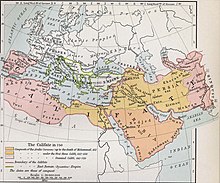| Abbasid revolution | |||||||
|---|---|---|---|---|---|---|---|
 The Caliphate in 750 | |||||||
| |||||||
| Belligerents | |||||||
| Abbasid caliphate | Umayyad caliphate | ||||||
| Commanders and leaders | |||||||
|
Ibrahim al-Imam As-Saffah Al-Mansur Abu Muslim Qahtaba ibn Shabib † Hasan ibn Qahtaba Humayd ibn Qahtaba Abd Allah ibn Ali |
Marwan II Nasr ibn Sayyar † Yazid ibn Umar | ||||||
The Abbasid revolution (Arabic: الثورة العباسية, romanized: ath-thawra al-ʿAbbāsiyya), also called the Movement of the Men of the Black Raiment (حركة رجال الثياب السوداء ḥaraka rijāl ath-thiyāb as-sawdāʾ),[1] was the overthrow of the Umayyad caliphate (661–750 CE), the second of the four major caliphates in Islamic history, by the third, the Abbasid caliphate (750–1517 CE).
The Abbasid revolt originated in the eastern province of Khorasan in the mid-8th century, fueled by widespread discontent with Umayyad rule. The Abbasids, claiming descent from Muhammad's uncle Abbas, capitalized on various grievances, including discrimination against non-Arab Muslims (mawali), heavy taxation, and perceived impiety of Umayyad rulers.[2] Led by Abu Muslim Khorasani, the rebellion united diverse groups, including Persians, disaffected Arabs, and Shi'a supporters, under the banner of restoring rule to the Prophet's family. The revolutionaries adopted black as their color and advanced westward, defeating Umayyad forces. The decisive Battle of the Zab in 750 CE saw the Abbasid army triumph over the last Umayyad caliph, Marwan II. This victory led to the fall of the Umayyad dynasty and the establishment of Abbasid rule, marking a significant shift in the caliphate's power base from Syria to Iraq and ushering in a new era of Islamic governance.[3]
- ^ Frye, R. N.; Fisher, William Bayne; Frye, Richard Nelson; Avery, Peter; Boyle, John Andrew; Gershevitch, Ilya; Jackson, Peter (1975). The Cambridge History of Iran. Cambridge University Press. ISBN 9780521200936.
- ^ Marín-Guzmán, Roberto (1994). "THE 'ABBASID REVOLUTION IN CENTRAL ASIA AND KHURĀSĀN: AN ANALYTICAL STUDY OF THE ROLE OF TAXATION, CONVERSION, AND RELIGIOUS GROUPS IN ITS GENESIS". Islamic Studies. 33 (2/3). Islamic Research Institute, International Islamic University, Islamabad: 227–252. ISSN 0578-8072. JSTOR 20840168. Retrieved 16 September 2024.
- ^ Hala Mundhir Fattah, A Brief History of Iraq, p. 77. New York: Infobase Publishing, 2009. ISBN 9780816057672